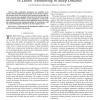Free Online Productivity Tools
i2Speak
i2Symbol
i2OCR
iTex2Img
iWeb2Print
iWeb2Shot
i2Type
iPdf2Split
iPdf2Merge
i2Bopomofo
i2Arabic
i2Style
i2Image
i2PDF
iLatex2Rtf
Sci2ools
TITB
2010
2010
The RFID technology for neurosciences: feasibility of limbs' monitoring in sleep diseases
This contribution investigates the feasibility of the passive UHF RF identification technology for the wireless monitoring of human body movements in some common sleep disorders by means of passive tags equipped with inertial switches. Electromagnetic and mechanical models as well as preliminary experimentations are introduced to analyze all the significant issues concerning the required power, the tag antenna design, the read distance, and the expected biosignals collected by the interrogation device.
| Added | 22 May 2011 |
| Updated | 22 May 2011 |
| Type | Journal |
| Year | 2010 |
| Where | TITB |
| Authors | Cecilia Occhiuzzi, Gaetano Marrocco |
Comments (0)

